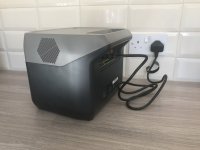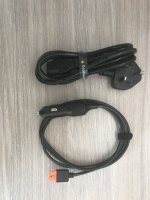My first thoughts on the River 2 Pro:
After nearly a week of using it around the house to get used to it my first thoughts are it’s a great bit of kit and will be useful to be able to take to take power anywhere.
What I like:
1/ The ability to alter the charge rate.
This is very important to me as I’ve got solar on the roof. Some day we can be generating up to 3kWh at any time, on a cloudy day it could be 300-500W. The ability to alter the charge rate to surplus solar power means I can only use surplus solar to charge it.
A lower charge rate should also help battery life as rapid charging of batteries increases deterioration of batteries. It’s good to have rapid charging for the times it’s needed.
2/ All front facing output ports and rear facing charging ports.
It’s a neat and tidy solution having everything in one place. It just makes sense to me. I can always have the power station facing outwards and get access to everything.
3/ no need for AC power transformer accessories- cables only.
One benefit I’ve noticed due to USB-A and USB-C ports is that won’t need to take the AC power plugs with me. I won’t necessarily need to take the AC power plugs for my phone, tablet or laptop as I can use the USB ports to power those devices.
4/ charging cable doesn’t have an external power transformer brick - it’s just a 230V ‘kettle’ plug.
This is great to ease charging. It’s just neat and simple.

A neat little touch is the cable tie wraps on the AC charging lead and the DC cigarette charging lead. I like little touches like this that keep cable nest and tidy when not in use.

5/ control and visibility via the app.
The app is really good. It can be charging or operating in another room and I can be keeping an eye on it via the app.
6/ flat top with slightly raised edges.
The flat top is a great place to put your phone or tablet on whilst it’s charging via the power station. The top of the River 2 Pro is a near perfect fit for my 9.7 inch iPad.
7/ LiFePO4 battery - increased life expectancy.
The LFP battery technology increases life cycles to over 3000 to 80% capacity. That’s impressive long life and much better than older power stations that had around 500 lifecycles. This a big reason why I’ve finally bought a power station.
Downsides:
1/ There is a cooling fan that runs intermittently during use and charging.
The cooling fan runs intermittently. Ive tested the noise level via an app on my phone. Its 28dB within a couple of cm from the fan vent and around 20dB at head level when standing about a foot away.
I don’t find it that bad, others may though. The fan is doing an important job to maintain the battery life so i don’t mind it. I’ve ran the TV off the river 2 pro whilst the fan has kicked it. It’s not loud enough that I couldn’t hear the TV sound but it’s audible none the less.
2/ the AC charging cable has a straight plug.
This is only a small niggle. The AC charging cable is a standard ‘kettle plug’ and sticks out slightly beyond the handle meaning it can’t be pushed back against a wall whilst the AC charging plug is connected as it would strain the cable.
The DC cigarette charging cable plug is smaller so it doesn’t stick out as far and the cable could downwards without being strained.
In both cases it would be nice if the plug connectors were L shaped so the cables pointed downwards and where protected by the overhanging handle.
3/ there is no wireless charge pad on the flat top of the unit.
Some may see this as a downside but I can understand why there isn’t one. Wireless charging isn’t an efficient way to charge a phone. It takes longer and uses more power to charge wirelessly than via a cable. If you’re charging via a power station with a finite power capacity why would you want to waste some of that power just for a slight convenience of not plugging in?
Charging:
AC charging is very easy and adaptable charge rates are great.
I haven’t yet tried in car charging and I don’t have portable solar panels so can’t try them.
To be honest portable solar wouldn’t be right for me as they would take far too long to charge and I likely won’t be in one place long enough. I will likely be using the in car cigarette charger as my main means of charging whilst in the campervan as I probably won’t have access to AC charging power that often, unless at a camp site. The river 2 pro isn’t something I’d charge in a coffee shop as firstly it’s too big, secondly it’s too noisy with the fan running when charging and thirdly charging something of this capacity off someone else’s power you’re not paying for is taking the mickey when energy costs are so high for businesses. Hopefully in vehicle charging will be sufficient for me.
Would I but the River 2 pro again?
I’d definitely buy the River 2 series or Delta 2 series if I didn’t have one now. Whether I’ve bought the right one for my needs I’m not 100% sure as I seem to be changing them from my initial reasons to purchase one. It works perfectly for my outdoor/photography needs as it powers all my photography equipment fine. It powers a milk frother to make hot chocolate/latte whilst out which is something I’d like it to do. It should also power a 600W kettle and a 800W induction plate too if I bought them too. Whether it’s got the storage capacity is another thing to consider but for my initial photography considerations it works fine.
I’ve tried powering our 900W microwave but the microwave made a strange zapping noise whilst trying to run it so I quickly turned it off. My initial idea wasn’t to power stuff around the house, but a potential electricity tariff change means it would be good to power stuff between 1600 and 1900 as we will be power to a solar tariff which is better for us but has a 49p per kWh unit rate during those times. If I’m honest a power station isn’t the right solution for that (home solar dtorage battery would be the right solution) so it’s a bit harsh to judge it on something it wasn’t intended to do in the first place.
If I wanted this as a power station to power everything in a campervan I’d probably wait until the higher capacity delta 2 series are out. Otherwise the River 2 series seem like a good bet for most people.
All in all I’m happy with the purchase and look forward to having power available when out and about in the future.



